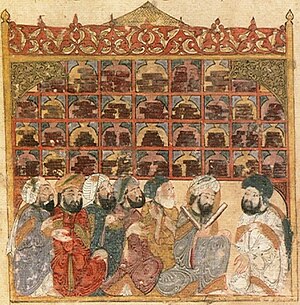
Back Huis van Wysheid Afrikaans بيت الحكمة Arabic بيت الحكمه ARZ Hikmətlər evi Azerbaijani Дом Мудрасці Byelorussian Дом на мъдростта Bulgarian বাইতুল হিকমাহ Bengali/Bangla Kuća mudrosti BS Casa de la Saviesa Catalan Bajt al-Hikma Czech
| House of Wisdom | |
|---|---|
| بَيْت الْحِكْمَة | |
 | |
 | |
| Location | Baghdad, Abbasid Caliphate (now Iraq) |
| Type | Library |
| Established | c. 8th century CE |
| Dissolved | 1258 (Mongol conquest) |
The House of Wisdom (Arabic: بَيْت الْحِكْمَة Bayt al-Ḥikmah), also known as the Grand Library of Baghdad, was believed to be a major Abbasid-era public academy and intellectual center in Baghdad. In popular reference, it acted as one of the world's largest public libraries during the Islamic Golden Age,[1][2][3] and was founded either as a library for the collections of the fifth Abbasid caliph Harun al-Rashid (r. 786–809) in the late 8th century or as a private collection of the second Abbasid caliph al-Mansur (r. 754–775) to house rare books and collections in the Arabic language. During the reign of the seventh Abbasid caliph al-Ma'mun (r. 813 – 833 AD), it was turned into a public academy and a library.[1][4]
Finally, it was destroyed in 1258 during the Mongol siege of Baghdad.[4] The primary sources behind the House of Wisdom narrative date between the late eight centuries and thirteenth centuries, and most importantly include the references in Ibn al-Nadim's (d. 995) al-Fihrist.[5]
More recently, the narrative of the Abbasid House of Wisdom acting as a major intellectual center, university, and playing a sizable role during the translation movement has been understood by some historians to be a myth, constructed originally over the course of the nineteenth and early twentieth centuries by Orientalists and, through their works, propagated its way into scholarship and nationally-oriented works until more recent re-investigations of the evidence.[6][7][8]
- ^ a b Dimitri Gutas (1998). Greek Thought, Arabic Culture: The Graeco-Arabic Translation Movement in Baghdad and Early ʻAbbāsid Society (2nd–4th/8th–10th Centuries). Psychology Press. pp. 53–60. ISBN 978-0415061322.
- ^ Jim Al-Khalili (2011). "5: The House of Wisdom". The House of Wisdom: How Arabic Science Saved Ancient Knowledge and Gave Us the Renaissance. Penguin Publishing Group. p. 53. ISBN 978-1101476239.
- ^ Chandio, Abdul Rahim (January 2021). "The house of wisdom (Bait Al-Hikmah): A sign of glorious period of Abbasids caliphate and development of science". International Journal of Engineering and Information Systems. ISSN 2643-640X. Archived from the original on March 26, 2023. Retrieved July 9, 2022.
- ^ a b Brentjes, Sonja; Morrison, Robert G. (2010). "The Sciences in Islamic Societies". The New Cambridge History of Islam. Vol. 4. Cambridge: Cambridge University Press. p. 569. ISBN 978-0521838245
- ^ İhsanoğlu, Ekmeleddin (2023). The Abbasid house of wisdom: between myth and reality. London New York, NY: Routledge. pp. 9, 25. ISBN 978-1-032-34745-5.
- ^ İhsanoğlu, Ekmeleddin (2023). The Abbasid house of wisdom: between myth and reality. London New York, NY: Routledge. ISBN 978-1-032-34745-5.
- ^ Khaleb, Dana (2023). "Ekmeleddin Ihsanoğlu, Abbasid House of Wisdom". Almagest. 14 (1): 210–214. doi:10.1484/J.ALMAGEST.5.134615. ISSN 1792-2593.
- ^ Hannam, James (2023). The globe: how the Earth became round. London: Reaktion books. p. 182. ISBN 978-1-78914-758-2.